Human Eye and colourful world
In chapter Human Eye and colourful world: we will study: The Human Eye, Structure of the Human Eye, The range of Vision, Power of Accommodation, How Pupil Works?, Persistence of Vision, Defects of Vision and their Correction, Dispersion of white light by a glass prism, Recombination of white light, Color of Sunrise and Sunset, Twinkling of Star, Why the danger signal or sign is made of red color?, Atmospheric Refraction, Formation of the rainbow

Human Eye and colourful world
1. Main parts of human eye
Cornea:
The outermost transparent parts of eye, which allow light to fall on eye
called cornea.
Iris and Pupil:
The iris is a colored ring, which has a circular hole in its centre, called pupil; the iris can control the amount of light by adjusting the size of pupil.
How Pupil Works?
- When the light is bright: Iris contracts the pupil, so that less light enters the eye.
- When the light is dim: Iris expands the pupil, so that more light enters the eye.
Lens:
It is a double convex lens behind the pupil and held by cilliary muscles its refractive index is about 1.43. it focus the image of an object on retina.
The typical minimum focal length of the human eye is 22.7 mm (2.27 cm). The typical maximum focal length of the human eye is 25 mm (2.5 cm). Therefore, the nominal focal length of the human eye is generally taken as 22 mm (2.2 cm).
Retina:
It is a screen, which obtain the image of an object. It is consist of rods and cones, which sense light intensity and color respectively. They transmit electrical signals via optical nerve to the brain.
Aqueous and Vitreous Hummer:
These are the fluid, which protect eye and clean.
2. Working of Human Eye
When we look at an object, light from the object enters the pupil of the eye and fall on the eye lens. The eye lens forms a real and inverted image on the retina of the eye.
The retina of the eye contains special cells in the shape of cones and rods. This cell converts light energy into electrical signals. These signals are carries to the brain through optical nerves. The brain finally forms the image of the object.
3. Power of Accommodation:
The process by which cilliary muscles changes the focal length of eye lens in such a way that the shape image is formed on retina is known as power of accommodation.
The value of the power of accommodation of the normal human eye is
(d = 25 cm) = 100/f = 100/d = 100/25 = 4 Dioptre.
For normal eye power of accommodation is 4D.
Near Point:
The nearest point from an eye at which a object can be seen clearly is called near point for a normal eye this distance is 25cm and called least distance of distinct vision (d).
Far Point:
The farthest point from an eye at which a object can be seen clearly called far point, for a normal eye far point is at infinity.
Range of Vision:
The distance between near point and far point called the range of
vision, i.e 25 cm. to infinity.
Persistence of Vision:
It is the time for which the sensations of an object continue in the eye. It is about 1/16th of a second.
Color Blindness:
A person having defective cone cells is not able to distinguish between the different colors. This defect is known as Color Blindness.
4. Defects of Vision of Eye:
(a) Myopia or Short Sightedness:
(b) Long Sightedness i.e. Hypermetropia
(c)Presbyopia
(a) Myopia or Short Sightedness:
The defect due to which we can see nearby object clearly but
cannot see far away objects clearly called myopia.
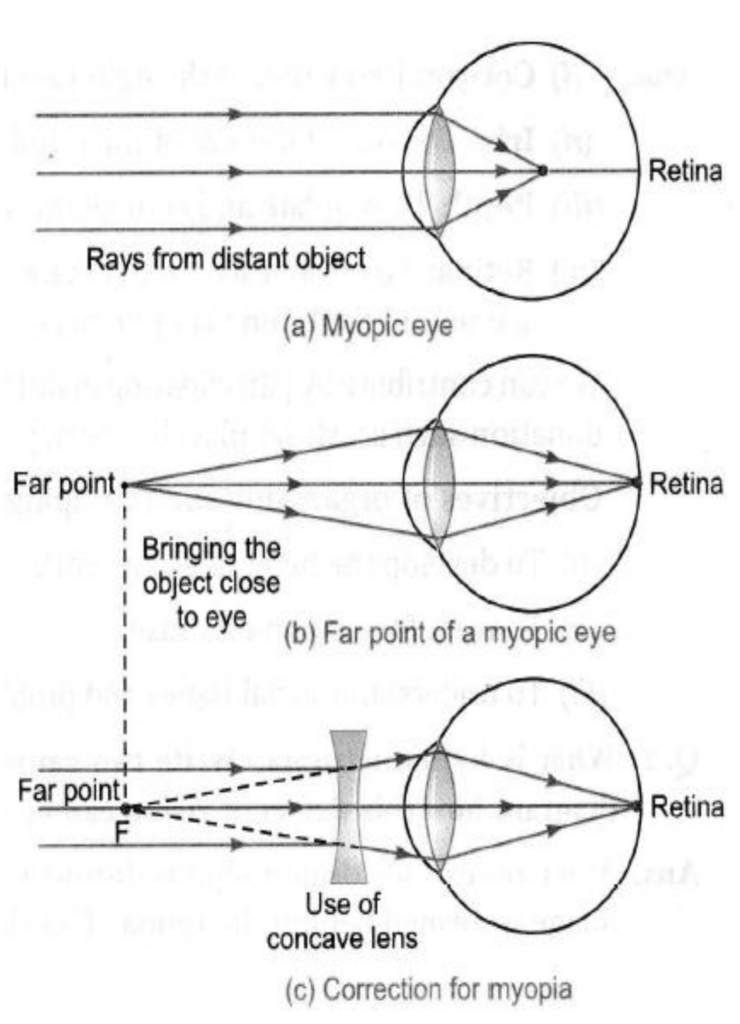
Cause:
It may be to increase in length of eye ball.
Due to decrease in focal length of eye lens.
Correctness:
This defect can be corrected by using a concave lens of suitable focal length. The concave lens diverge the ray of light entering the eye as shown in fig.
(b) Long Sightedness i.e.
Hypermetropia:
Human eyes which cannot see nearby objects clearly but can see far away object clearly called long sightedness or Hypermetropia.
Cause of Hypermetropia:
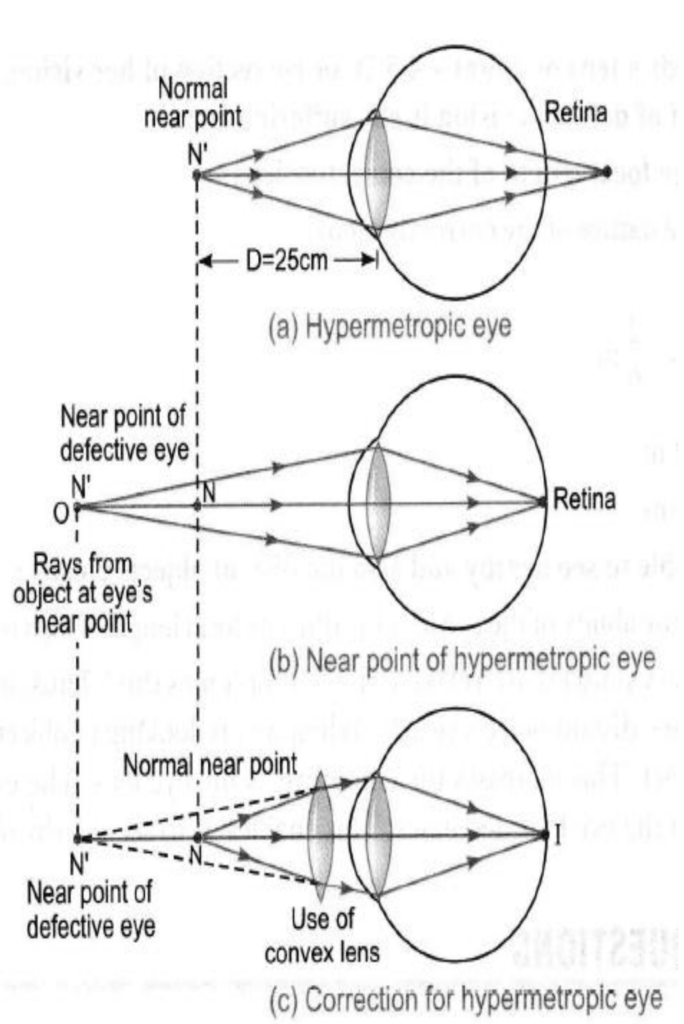
- This defect arises due to increase in focal length of eye lens.
- Due to decrease in size of eyeball.
Correction of Long Sightedness:
Long sightedness can be corrected using convex lens of proper focal length.
(c) Presbyopia:
A human eye, which cannot see near objects as well as distance objects clearly us said to suffer from a defect known as presbyopia.
Cause:

This defect arises in old age due to weakness in cilliary muscles and in decrease of flexibility of the crystalline lens.
Correction:
This defect can be corrected by using bi focal lens i.e. a lens that is a combination of convex and concave lens.
Human Eye and colourful world
Prism:
A prism is a homogeneous transparent refracting medium bounded by at least two non-parallel plane surfaces inclined at an angle. As we have studded total internal reflection through a prism. Now in this chapter we will study two more phenomenon associated with prism.
(i)Deviation (ii) Dispersion
5. Dispersion of Light through a Prism:

The phenomenon of splinting of white light into seven colors on passing through a prism is called dispersion of light.
The pattern of these seven colors is called spectrum of light and called VIBGYOR means violet, indigo, Blue, Green, Yellow, Orange and Red.
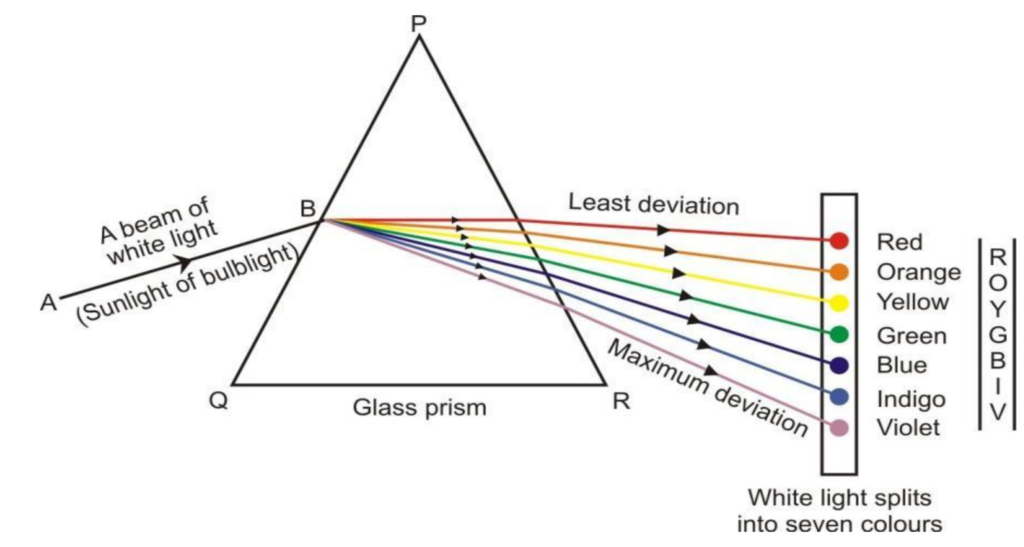
Cause of Dispersion:
Different color have different-different wavelength so different refractive index, again due to different refractive index they deviate at different angles so dispersion of light occurs.
we observe that as ![]()
6. Refraction Though a Prism
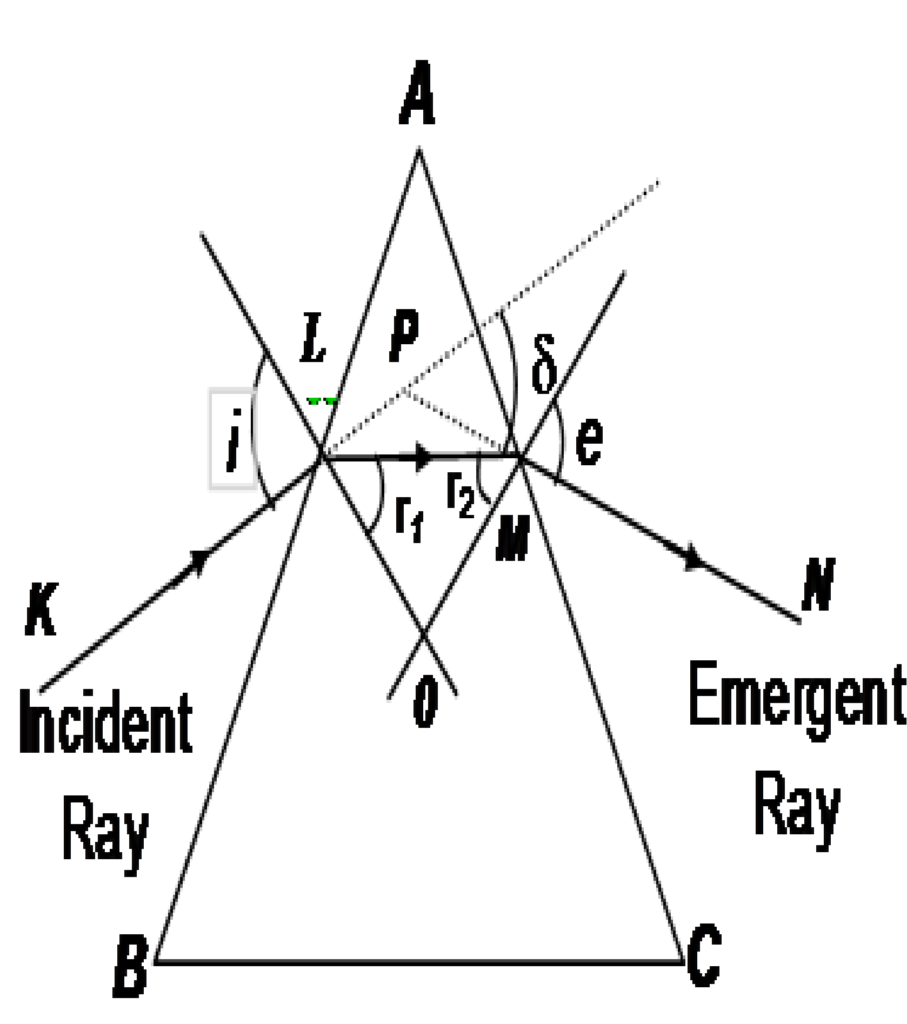
Suppose a ray of light fall on a prism of angle of prism A and suffer refraction through prism, as shown in fig. If light suffer no refraction then it moves without any deviation here the angle between incident ray and emergent ray is called angle of deviation ( ![]() ).
).
7. Rainbow:
A rainbow is a spectrum of colors in from of circular arcs, which forms in sky due to total internal reflection, and dispersion of light by rain drops during or after the shower (rain).
The essential condition for observing rainbow is the head of person should be in opposite to sun.
Rainbow have two parts:
Primary Rainbow:
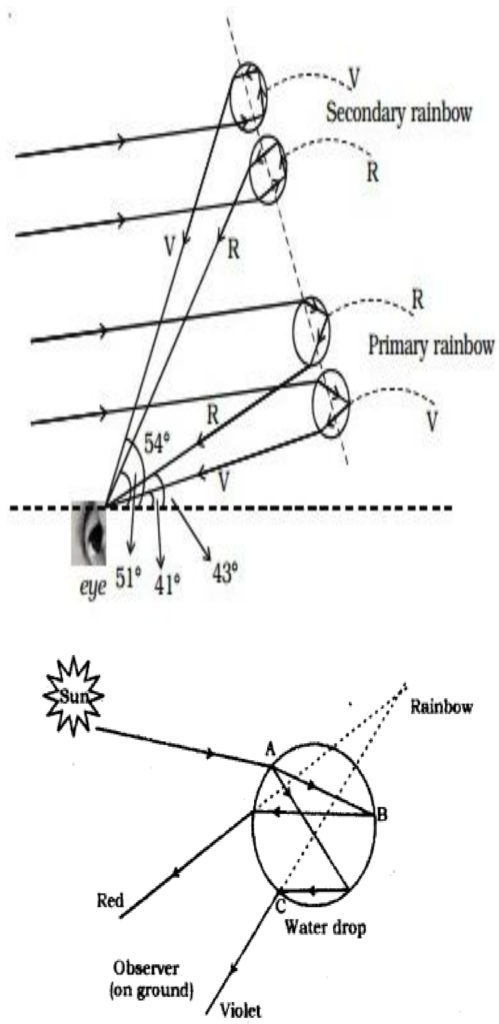
The inner of the two bows is primary rainbow; it forms due to two refraction and one total internal reflection at an angle 42. In primary rainbow violet color is in low at 41 and red color on top at 43. This rainbow is bright.
Secondary Rainbow:
The outer of the two bows is secondary rainbow, it is formed due to two refraction and two total internal refractions. Its lower color is red 51 and upper color is violet at 54. The mean position of rainbow formation is 52.5. it is less bright then primary rainbow.
Monochromatic light:
Light consisting of single color or wavelength is called
monochromatic light, example; sodium light.
Polychromatic light:
Light consisting of more than two colors or wavelengths is called polychromatic light, example; white light.
Recombination of white light:
Newton found that when an inverted prism is placed in the path of dispersed light
then after passing through the prism, they recombine to form white light.
Issac Newton’s experiment
He was the first, who obtained spectrum of sunlight by using glass prism. He tried to split the spectrum of white light more by using another similar prism, but he could not get any more colors.
He repeated the experiment using second prism in inverted position with respect to the first prism. It allowed all the colours of spectrum to pass through second prism. He found white light emerges on the other side of second prism.
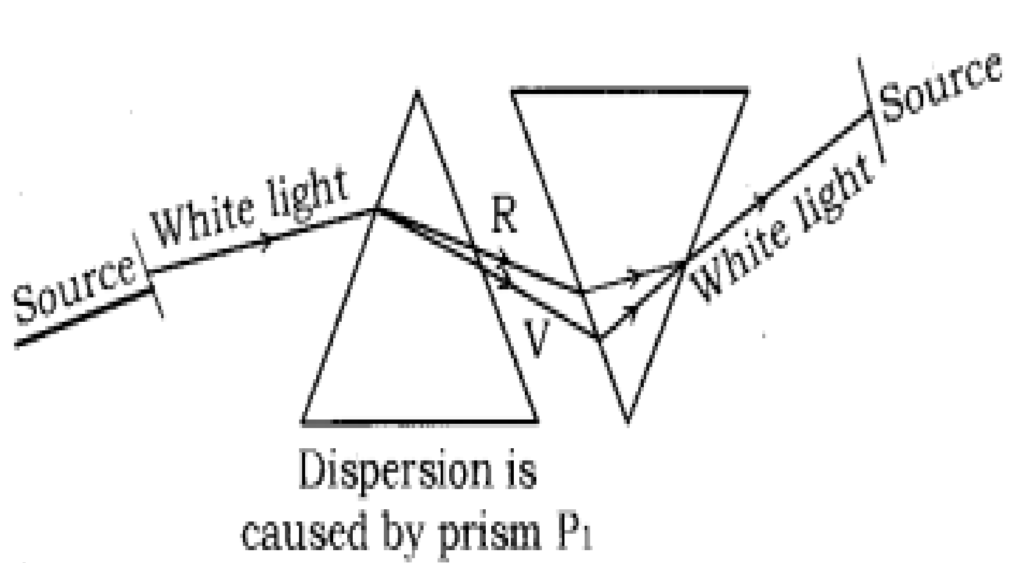
He concluded that Sun is made up of seven visible colors VIBGYOR.
7. Scattering of Light:
Scattering of Light:
The process of splitting the light by the tiny particles in all directions by absorbing light is called scattering of light. The atom or molecules which scatter the light is called scatter.
According to ray Leigh, the intensity of scattered light varies inversely to the forth power of wavelength.
i.e. ![]()
Means for scattering of light the size of particle should be small and comparable of wavelength of light. If size of particle is large then scattering does not observed i.e. all wavelengths emits equally.
8. Some Phenomenon Associated with Scattering of Light
a. Blue Color of Sky:
When white light from sun entre into earth’s atmosphere then by small sized particle scattering occurs. As wavelength is violet color is small as compared to red color, so its scattering is more as compare to other colors, that’s why sky looks blue, as it is comparable to size of particles.
b. While Color of the Clouds:
As clouds are very near to the earth and consist of large sized water molecules, dust etc. so scattering of all the colors is equals, these scattered color merge together and act as white color. So clouds appear white.
c. Danger Signals are Red:
As red color have large wavelength so small deviation or scattering and can be seem from a large distance so danger signals are formed red colored.
d. Reddish Color of Sun at Sun Rise and Sun Set:
At sunrise and sun set the sun is at large distance. So different colors having smaller wavelength, scatter in the atmosphere and red color suffer small scattering due to large wavelength. So reaches at over eyes. So sun looks reddish at sun rise and sun set.
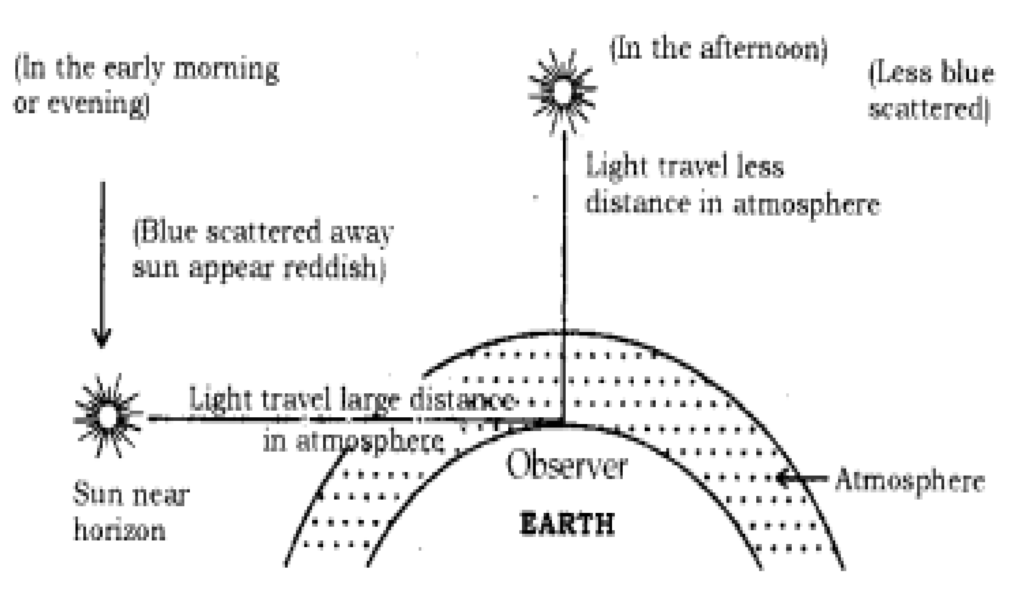
9. Tyndall Effect:
When a beam of light strikes, the minute particle of earth’s atmosphere, suspended particles of dust and molecule of air the path of beam become visible. The phenomenon of scattering of light by the colloidal particle gives rise to Tyndall Effect.
It can be observed when sunlight passes through a canopy of a
dense forest.
The color of the scattered light depends on the size of the scattering particles.

10 Atmospheric Refraction:
The refraction of light caused by the Earth’s atmosphere (having air layers of varying optical densities) is called Atmospheric Refraction.
Application of atmospheric refraction of light
1. Appearance of Star Position:
It is due to atmospheric refraction of star light. The temperature and density of different layer of atmosphere keeps varying. Hence, we have different medium. Distant star act as point source of light.
When the starlight enters the Earth’s atmosphere, it undergoes refraction continuously, due to changing refractive index i.e. from Rarer to denser. It bends towards the normal. Due to this, the apparent position of the star is different from actual position. The star appears higher than its actual position.
11 Application of atmospheric refraction of light
Why do stars twinkle ?
Stars appear to twinkle due to atmospheric refraction. The light of star after the entry of light in earth’s atmosphere undergoes refraction continuously till it reaches the surface of the earth. Stars are far away. So, they are the point source of light.
As the path of light coming from stars keep changing, thus the apparent position of stars keep changing and amount of light from stars entering the eye keeps twinkling. Due to which a star sometimes appear bright and sometimes dim, which is the effect of twinkling.
Explain why the planets do not twinkle ?
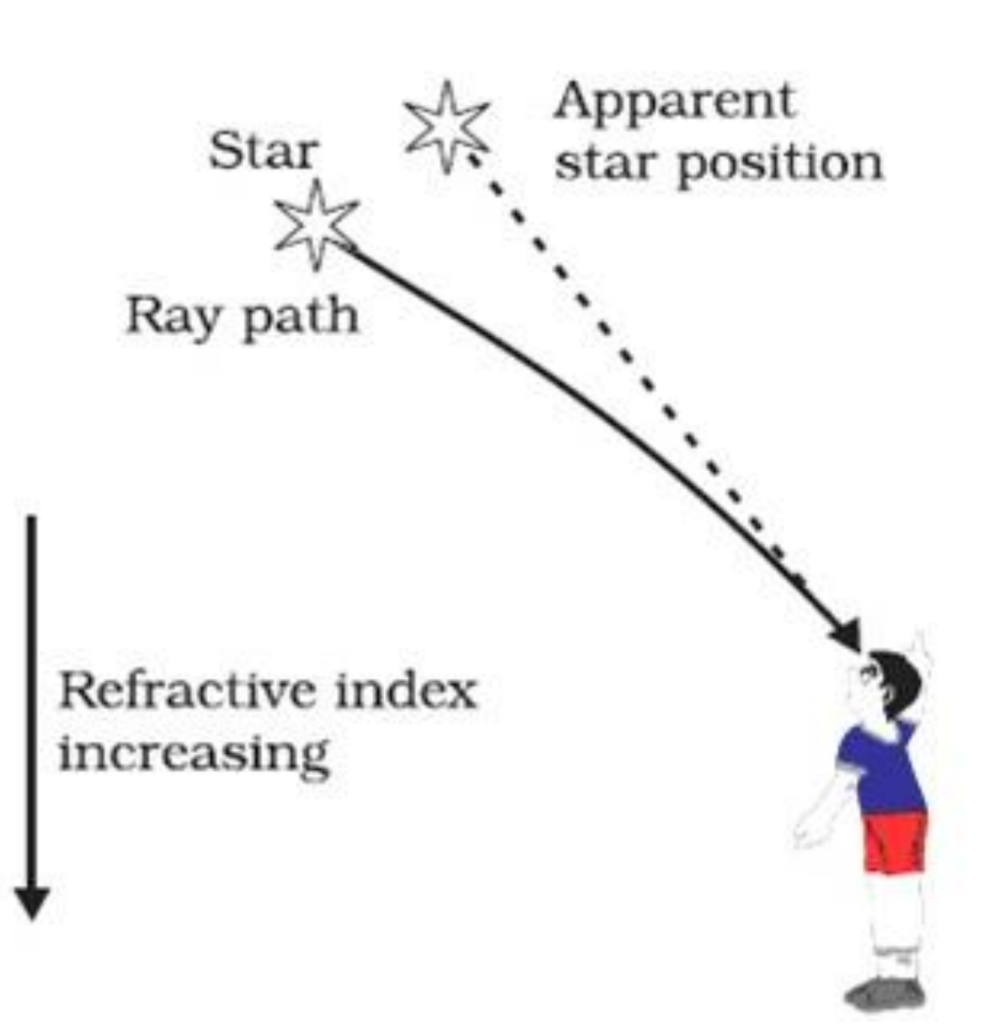
The planets are much nearer to the earth than stars and because of this they can be considered as large source of light. If a planet is considered to be a collection of a very large number of point sources of light, then the average value of change in the amount of light entering the eye from all point size light sources is zero. Due to this the effect of twinkling is nullified.
3. Apparent shift of the Sun at sunset and sunrise

Due to atmospheric refraction, the sun is visible before actual sunrise and after actual sunset.
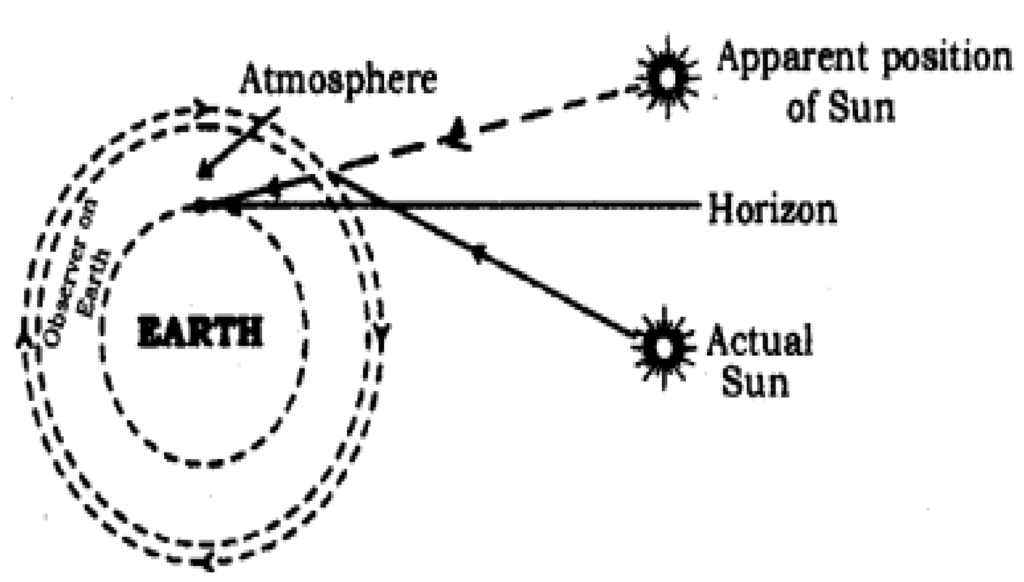
As we know near the surface of earth, the density of gasses is large so it behaves like denser medium. When a ray of light comes from sun below horizon toward earth, then light travel from rare to denser medium. Due to multiple refractions , the apparent sun seen above the horizon before two minute then its actual sunrise. Similarly at sun set it seen after its sunset. Therefore, we can say that our day becomes 4 minute bigger than actual.
Why does the sky appear dark instead of blue to an astronaut?
As an astronaut moves away from the atmosphere of earth, the atmosphere becomes thin. Due to the absence of molecules (or dust particles) in air, the scattering of light does not take place. Thus, sky appears dark in the absence of scattering.

To download class notes of chapter 10
Human Eye and colourful world click on the link given below
Human Eye and colourful world
